Abstract
In this paper, we publish the algorithm to create a dual image manifested in the infrared and visible spectrum. To distinguish the information in the two light spectra, twin dyes are introduced for the inkjet plotter and printing realization for garment and canvas items. The graphics, invisible to the naked eye, are designed for the near infrared (NIR) spectrum and are suitable for urban security where surveillance cameras with IR detectors are installed. The duality of dyes is presented in tables, and the analysis is a basis for programming and developing new algorithms for the application of “Infrared Dyeing” on different materials and printing technologies. Through spectroscopy, this innovative solution demonstrates twin colorants by printing in one pass through the plotter such that one image remains visible, while the other one is hidden to the bare eye. The uniform and the school bag cover presented in this paper are kept simple in design because they incorporate information hidden to the naked eye but visible with surveillance cameras and all the other infrared detectors. The article provides mathematical models of duality coloring as a basis for programming the graphic prepress that merges both of the images, the visual one and the infrared one. A topic is the fusion of two images with colors that represent two graphs, with independent contents for the visual and near-infrared spectrum.
1. Introduction
The digital technology of hidden data in uniform design extends from the visual to near-infrared spectrum. The software solution in INFRAREDESIGN® technology of merging two images was preceded by the study of twin colors for textile material [1]. By spectroscopy of dyes and pigments, we obtained accurate results about the properties of each colorant in two spectral states: visual and infrared. In digital inkjet printing, our new enhanced GCR method (gray component replacement) was introduced to provide separate color matching for the visual and NIR spectra [2,3]. The enhanced near-infrared (NIR) information is embedded in the existing visual design, which remains in its initial form. The garment is given a dual detection state, separated by two spectral regions: visual and near-infrared. The formulations for the dual twin colors are presented by using spectroscopy in the extended light range from 750 to 1000 nm [4].
The idea of applying infrared (IRD) printing on clothing contributes to the development of a new generation of uniforms and camouflage cover for target groups [1]. Infrared printing on clothing and garments is performed with screen printing or conventional ink-jet inks. The novelty in the IRD algorithm with which it is planned to provoke dual design and their appearance separately in the visual and infrared spectrum does not depend on the height of the edition, i.e., on the number of copies of such clothing.
2. Security in the Urban Environment
In this paper, innovations are discussed to improve safety in urban environments to track pedestrians as part of managing personal safety in communities. There are several computer-vision-based techniques that are used in managing traffic flow, especially at intersections, and are related to this purpose. Dual graphics is based on simultaneous observation in two spectrums of light [5]. Clothing and uniforms are designed to take advantage of the properties of different light absorption in two spectra. [6,7]
The authors propose the dual design of an image that automatically identifies pedestrians using dual cameras that are installed on the road. With these dual cameras, it is possible to detect and distinguish individuals wearing marked clothing that is not visually noticeable or salient, while they have individualized markings in the hidden NIR spectrum [8]. With the inclusion of parallel, simultaneous observation in two light regions, the topic of detecting, tracking, and searching for an individual or group expands. This solution allows the selection of a tagged person in the infrared spectrum and the possible monitoring of their movement without being visually tagged and attracting special attention [9].
The creation of INFRAREDESIGN® (IRD) is similar to the design of protected documents [10]. Security is divided into two views: The first technique is “Infrared Reflectography” (IRR), which detects the radiation in the first part of the infrared wavelength range, which is from 750 to 1000 nanometers [11]. Another technique is conventional photography in the visual spectrum of our eye [12,13]. Taking two different photographs with two different NIR and RGB cameras, two different information components were perfected to plan inkjet printing on canvas [1]. In that way, the fabric gets a hidden image which can be seen by double surveillance cameras in front of different institutions, buildings or in the street [14]. The parallel IRR photography is shown in this paper. Figure 1 shows the urban situation of the schoolchildren crossing the street with the school bag applying NIR design.
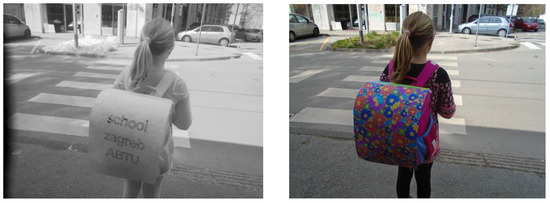
Figure 1.
A schoolchild with a bag on her back, photographed with Z and RGB cameras [12,13].
The video of night movement uses its additional source of NIR radiation [9].
The subject of our research is the comparison and differentiation between two states of clothes (V and Z) as an expansion of information with surveillance cameras. We are surrounded with many different types of cameras in schools, hospitals, banks, galleries and in the street. Our proposal is to use the ZRGB camera [12,13], which means that two cameras simultaneously observe and register. ZRGB video cameras record two parts of the spectrum during the day: the RGB (V, the visible spectrum from 400 to 750 nanometers) and the NIR-Z. Our first camera Z has a filter that records the spectrum at 1000 nm. We propose a camera Z that does not have its own source of IR radiation but uses this component from sunlight. Since it uses sunlight as the source of radiation, such NIR recording does not depend on the distance between the camera and the object. This system of duality works only with sunlight. In closed spaces with artificial sources of light (fluorescents, for example), there is no guarantee that the artificial light is a satisfactory source of the NIR component.
The design and implementation of information about clothing is designed for infrared cameras that are ubiquitous in urban areas [1].
The authors of the paper propose an image-processing-based approach for pedestrian identification, using dual cameras. Pedestrian detection models are developed that contain dual information for two spectral light regions. The first information component is for a visual (RGB) camera, and the second information component is registered at the same location (satchel) but with a NIR camera. Covert graphics are individualized, readable, and recognizable. NIR graphics are black and white, different from the environment, flora and fauna or colors on the roadway [9].
3. Methodology
Our applications of dual dyeing and expanded video surveillance are based on the properties of light absorbance of dyes for digital printing in the visible (V) and near-infrared spectrum (Z). Different color ranges—XYZ, HSB, and RGB—describe colors only in the visible spectrum of sunlight. In the printing industry, dyeing is done with dyes C, M, Y and K. The inkjet plotter used C, M, Y, K (HP Latex 330 Printer), as well as dyes for many other printing technologies, including offset printing. Dyes C, M and Y do not absorb NIR light. On the other hand, dye K (carbon black) strongly absorbs NIR light. The light absorption properties C, M, Y, and K are presented as spectrograms in Section 5. The CMYK is observed as a substance whose pigments absorb the NIR and the V spectra.
We introduced a new chapter in programming (Prepress) for producing a dual image—an image with separate content for the visible and NIR spectrum—into the printing industry. “Twin colors and dyes” are defined as dyes of the same color in the visible spectrum that absorb light differently in the NIR spectrum.
IRD is a fusion of two graphics that differ in the extended visual spectrum (RGB) and near infrared (NIR). The first image “RGB” is in the (print) colors C0, M0, and Y0 (cyan, magenta and yellow). The second image “Gr” is set as a multicolored gray image for instrumental observation with a NIR camera. The second image is in 40% coverage with the dye carbon black K, which is responsive to surveillance NIR cameras. The IRD technology (replacing C, M, Y with K) has limitations. It is intended to replace the value of K by C, M, and Y exactly as much as the value of Z in the gray image Gr. The maximum replacement (GCR) of C, M, and Y by K from the Gr image was determined based on the minimum value of one of the components C, M, and Y.
In hidden information design, the dual image for recognition with cameras already installed in the community is designed on clothes or work uniforms. The advantage of dual marking as “expanded information” is that it does not compromise personal integrity. The automatic recognition of vehicles and persons facilitates the effectiveness of law enforcement and traffic surveillance, and at the same time enables controlled monitoring of target groups, which significantly increases the safety of participants.
Figure 1 and Figure 2 present schoolbag covers that are designed for school children. The idea is that when leaving school or on field trips, children wear the class and school mark in the infrared spectrum while in the visual spectrum of the desired design and color without markings. Control and classification of persons is performed by hand-held, pocket detectors (IR money detector), which are commonplace and used in the verification of individuality.
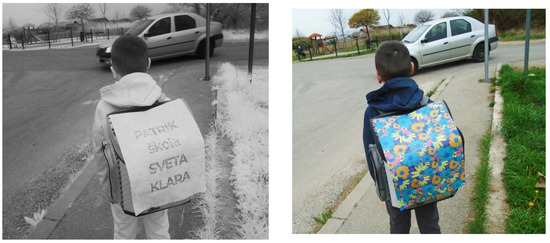
Figure 2.
A boy on the street with a hidden mark (ZRGB camera).
Figure 1 and Figure 2 show the design of school bags with colorful flowers. Figure 3 shows a girl in a solid black colored jacket. In all three proposals, a hidden image with individualized text was added, which is colored with 40% coverage with black ink, K. The intention is to recognize the text only with an NIR camera.
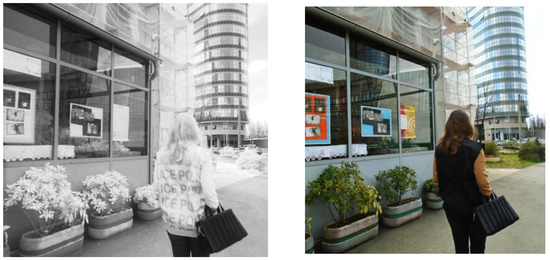
Figure 3.
Visit to the school recorded with dual ZRGB cameras.
Marking for two spectral areas was the initial idea of this article, with the intention of raising the safety of participants in the urban environment. Cities and traffic centers are specific because of the large number of inhabitants with uniformly colored and tailored clothing. Monitoring traffic, squares, and shopping malls with the aim of raising general security has become a priority for all participants. The IRD method of marking clothing enables discretion, normal visual condition and quick recognition via surveillance Z-RGB cameras.
We propose a more complex system of video surveillance in urban space with multi-purpose Z cameras. Cameras that have different, alternating, filters for detecting and recognizing information. Our first Z cameras had only one filter for 1000 nm. Today’s Z cameras have up to a dozen filters, with the intention of bringing out expanded information [11]. The multilayer of such digital records is shown as an animation of changes from 400 to 1000 nm: https://vilko.ziljak.hr/patrik.mp4 (accessed on 14 February 2022).
Records at 400, 530, 750 and 950 nm are illustrated (Figure 4). Such a representation is intended as a digital specimen and review information to determine the authenticity of clothing. The hidden image is information, information that is fully recognizable only with filters above 850 nm.
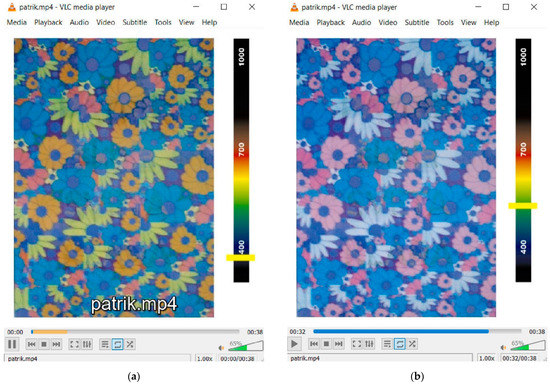
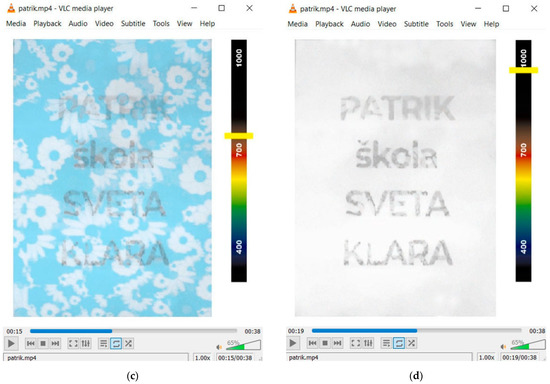
Figure 4.
(a) Animation stop on 400 nm; (b) animation stop on 530 nm; (c) animation stop on 750 nm; (d) animation stop on 950 nm.
Computer graphics with a secret feature are entered into graphic preparation procedures (Prepress) just before printing from the “personal data” base.
4. Mathematical Models of Dyeing as a Basis for Programming
Experimental measurements are the basis for the development of regression equations of the connection between the visual and near-infrared spectra. The color difference includes measured values from the colorimetry range respecting the parameters: L*a*b* and the value of ΔE (that is less than 3) [15]. The iterative process of printing and measuring the value of L*a*b* is performed on the same material on which the final sample is printed. Twin dye recipes for ink-jet printing are proposed. The reproduction of clothing uses its own printing inks.
Our IRD method is the fusion of two images [16] in the CMYK printing system. The first image (X0, K = 0%) is the one intended for the visible spectrum, while the second image (X40, K = 40%) is detectable only with an NIR-Z camera. Values C0, M0, and Y0 are the initial values of coverage for every individual pixel in the X0 image (V). These values decrease depending on the quantity of K in image Z. The programming has a starting point (X0) and the calculated point at 40% coverage of the carbon black toner in image Z. The remaining values between X0 and X40 are proportionally interpolated. The measurements of twin dyes (column X40) are interpreted (regression analysis) as analytical solutions for calculating other color tones in the visible image V.
The programming of dye mixtures is planned in two ways. The first plan is tabulated, taking the values of the mixtures. Only the offered colors, checked for the minimum value of ΔE, are used in this algorithm. A program is previously developed that tests the invisibility of the touch of the twin dyes with 20%, 40% and 0% content of the black component.
The second plan is an algorithm that uses regression Equation (1). This algorithm allows the use of all color shades. The regression model (1) is derived from the values obtained experimentally, which implies a limited number of calculated twin dyes.
A model with three independent variables is presented here. Each dye formulation depends on all three values of the initial (X0) components. The parameters in the regression Equation (1) of the twin dyes recipe are valid for ink-jet printing on a plotter and with inks for HP Latex 330 printing on white canvas. The twin dyes’ regression formulations (1) refer to 40% black ink coverage. In this paper, a relation used for programming CMYKIR separation is proposed.
C40 = −0.0441 × Y0 − 0.1988 × M0 + 1.1142 × C0 − 19.03
M40 = −0.2313 × Y0 + 1.0540 × M0 − 0.3078 × C0 − 7.44
Y40 = 1.1414 × Y0 − 0.1349 × M0 − 0.1169 × C0 − 32.05
M40 = −0.2313 × Y0 + 1.0540 × M0 − 0.3078 × C0 − 7.44
Y40 = 1.1414 × Y0 − 0.1349 × M0 − 0.1169 × C0 − 32.05
Relations determine the quantity of dyes C40, M40 and Y40, which manifest in the NIR and V spectrum, for the same color that manifests only in the visible spectrum C0, M0, and Y0. The interdependence measurement X40, X20 and X0, (Table 1) are continuously supplemented for different materials and printing techniques. Our research focuses on experimental printing on canvas and making a sample at the “prototype” level.

Table 1.
Twelve twin dyes (inkjet plotter).
5. Dye Spectroscopy in the Visual and Near-Infrared Spectrum
In order to achieve a double image with inks in a plotter, additional information about dyes, their position in two zones of light is required. No special colors are needed for infrared images, but the properties of these dyes are important: the penetration of ink into the canvas, the consistency of the colorant tone of the dye over a longer period of use of the print [12,13]. Therefore, when talking about infrared design, the word color is replaced by the word dye, which means that it is possible that the same color of different mixtures has different properties. The specific dye response to the infrared spectrum is the key to the solution for creating infrared images.
Process dyes are observed through their light absorption properties in the range of the visual and near-infrared spectra (400 to 900 nm). Spectrograms are performed with a Projectina device (PAG-24 blockade [11]). From Table 1, blue, olive, and red are presented. For precise determination of the C, M, Y, and K compounds of the dye, that is, to separate the information intended for the visual and NIR spectrum, spectroscopy is used. The amount of black component is the default. The adjustment of the twin components is intended for the range from 400 to 700 nm. In the range of 400 to 700 nm, all three dyes have the same spectral values and show the same color for our naked eye. The range from 700 to 800 nm (Z1) is the range of spectral divergence of absorption values for the same dye [4].
The red color is presented as twins with 20% coverage and with 40% carbon black. All three graphs (X0, X20, X40) match well in the visual spectrum, which is the initial task of color equality. Their separation starts at 700 nm and ends at three sizes: Z20, Z0 and Z40. These three sizes manifest as different gray tones in Z camera images.
The graph shows the absorptions of pure dye components: Y (52% and 66% coverage), magenta (50% and 86%) and cyan (57% coverage). Each of the process inks has its own domain of light absorption. Yellow has a maximum at 460 nm, magenta at 560 nm. Cyan ink has a wider domain with a maximum at 700 nm. Component graphs determine the domain of visibility (in our eye). Above 750 nm, inks C, M, and Y do not absorb light (Figure 5 and Figure 6).
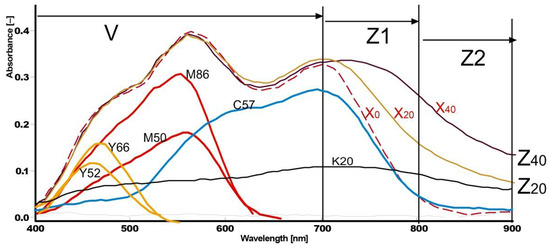
Figure 5.
Spectrograms of red color twins (12–Red 2).
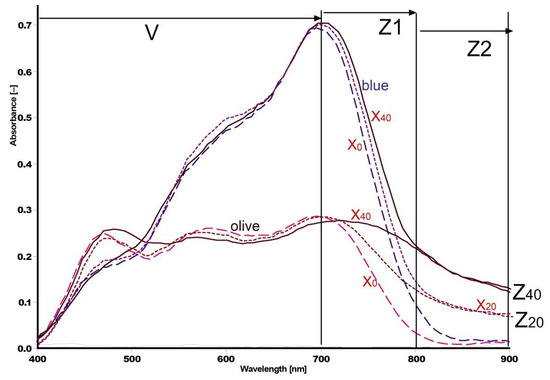
Figure 6.
Spectrograms of twins blue and olive colorants.
These process inks in printing are essential in understanding the programming of twin dyes combined with carbon black ink. Carbon black ink extends from 400 and further from 900 nm.
Due to the effect, the transparency properties of the dye, the common graphic representation of the dye is not a mere summation of the light absorption of the individual components.
Figure 6 shows two colors. Their absorption at 900 nm has common values, especially for 40% black carbon black color coverage and especially for 20% K dyes coverage. These values are the same for red color (Figure 6).
In the first part of the visual spectrum (400 to 700 nm, marked V), the two graphs are sufficiently similar that the numerical value ΔE satisfies the color equality criteria. The blue color has a maximum absorption at 700 nm. It is determined by the property of cyan dye. Other components do not absorb light in this area. After 700 nm, the twin dye graphs are separated (Z1). At 900 nm, their difference is shown, which is manifested in terms of ZRGB cameras [12,13].
The idea of IRD and twin dyes is based on the difference in absorption of individual components in the light zone above 800 nm. This is where our idea of creating twin dyes and using dual surveillance cameras for creative purposes began. The development of INFRAREDESIGN® moved designers into a new dual image space.
The new design method introduces new technologies that surround us, their ability to select the reception of light signals beyond the reach of our naked eye. The design of school bags, in the proposed design, is richly filled with an extreme color contrast. There are many shades of red tones for which digital models of twin dyes have been prepared. This paper presents examples of different ways of marking objects that are recognizable in a new way. Two spectrum areas, dual cameras, multiple individualized designs, are fully supported by computer graphics algorithms.
6. Discussion on the Application of IRD in Security in the Urban Environment
INFRAREDESIGN® is a new method of dual marking of clothing; it is the result of the experimental development of technology and software solution for applying the twin colorants on clothing and equipment of target groups. With IRD technology, the personal integrity and privacy of children carrying school equipment, extreme sports athletes, picnickers and others are not endangered, and we have the opportunity to find them in case of accidents and disappearances. With the help of formatting technology in the NIR spectral range, practical results are achieved that encourage the further development of digital systems for automatic detection of hidden messages.
For the needs of the presented solution, the technology of twin pigments was developed in this work. The same color was produced in several ways. One mixture is the dyes seen in the NIR spectrum, and the other groups of mixtures are not even seen instrumentally outside the sensitivity space of our eye. To each dye a numerical quantity was joined in order to determine its property of absorbing light in near infrared spectrum. Printing on fabrics aims to create a “message within a message” as a form of recognition and protection. Technology was developed for IRD inkjet printing in brand printing and technology for reading (detecting and distinguishing) hidden messages. This gave designers new tools to use in the creative design of a prototype in IRD technology. The idea is the transmission of information in two spectrums, that is, the detection of separate information, with the aim of increasing security in urban areas. To protect people, especially children in the community, this solution is intended for rapid detection by ubiquitous surveillance cameras.
7. Patents
Patents related to the work reported in this manuscript are as follows:
V. Žiljak, I. Žiljak, K. Pap, J. Žiljak-Vujić, “Infracrveni tisak s procesnim bojama” patent nr.: P20080466, 22.09.2008. Croatian State Intellectual Property Office, EU patent nr.: EP2165844, 24.03.2010., European Patent Office, Hrvatski patentni glasnik 3 (2010) 579, Trade mark: INFRAREDESIGN® 12.07.2013. OHIM- The Trade Marks and Designs Registration Office of the European Union.
V. Žiljak, I. Žiljak, K. Pap, J. Žiljak-Vujić, (Portrait reproduction protection procedure with security portrait), Croatian State Intellectual Property Office; Office for Patents, P20100201, 31.10.2011. RH Hrvatski patentni glasnik: 18 (2011) 3068.
V. Žiljak, I. Žiljak, K. Pap, J. Žiljak-Vujić, ZRGB apparatus for dual detection, patent nr.: P20100451A, 29.02.2012, Croatian State Intellectual Property Office, Hrvatski patentni glasnik: 2 (2012) 367.
V. Žiljak, I. Žiljak, K. Pap, J. Žiljak-Vujić, Dual marking within the visual and near infrared spectrum with screen printing technology, Croatian State Intellectual Property Office; Office for Patents, 27.01.2021, PK20191038, -Hrvatski patentni glasnik 26/2019.
Author Contributions
Conceptualization: J.Ž.G. and L.T.G.; Methodology: J.Ž.G. and V.Ž.; Software: V.Ž. and J.Ž.G.; Validation: L.T.G. and D.J.; Formal analysis: D.J., L.T.G. and V.Ž.; Investigation: J.Ž.G. and D.J.; Resources: J.Ž.G. and D.J.; Data curation: J.Ž.G. and V.Ž.; Writing—original draft preparation: J.Ž.G.; Writing—review and editing: L.T.G. and V.Ž.; Visualization: J.Ž.G. and D.J.; Supervision: L.T.G. and D.J. All authors have read and agreed to the published version of the manuscript.
Funding
This research received no external funding.
Institutional Review Board Statement
Not applicable.
Informed Consent Statement
Not applicable.
Data Availability Statement
Data is contained within the article.
Conflicts of Interest
The authors declare no conflict of interest.
References
- Žiljak Gršic, J.; Jurečić, D.; Morić Kolaric, B.; Jeličić, T. The Technique of Security Print on Textiles with a Hidden Sign in the Near-Infrared Spectrum. Tech. Gaz. 2020, 27, 633–637. [Google Scholar] [CrossRef]
- Pogarčić, I.; Agic, A.; Matas, M. Evaluation of the colorant twins for the neutral grey spectra in infrared graphic procedure. Tech. Gaz. 2016, 23, 1659–1664. [Google Scholar] [CrossRef][Green Version]
- Zhu, M.Z.; Chen, Z.; Liu, H.X. The Research on Special Printing Effects Based on Gray Component Replacement. Adv. Mater. Res. 2011, 174, 251–254. [Google Scholar] [CrossRef]
- Žiljak Gršic, J. Near infrared spectroscopy in print technology. Polytech. Des. 2017, 5, 32–36. [Google Scholar] [CrossRef]
- Crčić, D.; Žiljak Gršić, J.; Jurečić, D. Infrared Printing Technique for the Security Marking of Traceability Certificates for Meat Products. Tech. J. 2020, 14, 100–103. [Google Scholar] [CrossRef]
- Jana, Ž.; Lidija, T.G.; Denis, J.; Vilko, Ž. Hidden infrared graphics on a painted canvass. Int. J. Appl. Phys. 2017, 2, 18–23. [Google Scholar]
- Glogar, M.I.; Parac–Osterman, Ð.; Žiljak Stanimirovic, I. Comparison of Green Hues of Natural and Synthetic Dyes by VIS and NIR Analyses. In Book of Proceedings of 7th International Textile, Clothing & Design Conference; 2014; pp. 369–375. Available online: https://www.bib.irb.hr/720038 (accessed on 14 February 2022).
- Žiljak Gršić, J.; Tepeš Golubić, L.; Žiljak, V.; Jurečić, D.; Rajković, I. Design on Clothes with Security Printing, with Hidden Information, Performed by Digital Printing. In Applied Physics, System Science and Computers III; Ntalianis, K., Vachtsevanos, G., Borne, P., Croitoru, A., Eds.; Springer International Publishing: Cham, Switzerland, 2019; pp. 48–55. Available online: https://www.bib.irb.hr/1114673 (accessed on 14 February 2022). [CrossRef]
- Rajković, I.; Žiljak, V. Parallel motion images in visual and near infrared spectrum. Tech. Gaz. 2018, 25, 1004–1008. [Google Scholar] [CrossRef]
- Chambers, J.; Yan, W.; Garhwal, A.; Kankanhalli, M. Currency security and forensics: A survey. Multimed. Tools Appl. 2015, 74, 4013–4043. [Google Scholar] [CrossRef]
- Projectina Docucenter 4500. SP-2000 Color Spectroscopy Module & PAG B50 Custom Designed with 24 Barrier Filters, Switzerland. Available online: https://forensictechnology.com/projectina/ (accessed on 14 February 2022).
- Rajković, I.; Žiljak, V. Usage of ZRGB video camera as a detection and protection system and development of invisible infrared design. In Polytechnic & Design; Zagreb University of Applied Sciences: Zagreb, Croatia, 2016; Volume 4, pp. 54–59. [Google Scholar] [CrossRef]
- Žiljak, V.; Pap, K.; Žiljak-Stanimirović, I. Development of a prototype for ZRGB Infraredesign device. Tech. Gaz. 2011, 18, 153–159. [Google Scholar]
- Žiljak Vujić, J.; Zečević, M.; Žiljak, V. Simulation the colors from nature with twins dyes to camouflage military uniform. Tekstil 2015, 64, 89–95. [Google Scholar]
- Glogar, M. Ira, Parac-Osterman Ðurđica. Achromatic Hues Matching in Graphic Printing. Acta Graph. 2015, 26, 36–45. Available online: https://hrcak.srce.hr/145334 (accessed on 14 February 2022).
- Pap, K.; Ziljak, I.; Vujic, Z.J. Image Reproduction for Near Infrared Spectrum and the Infraredesign Theory. J. Imaging Sci. Technol. 2010, 54, 10502-1–10502-9. [Google Scholar] [CrossRef]
Publisher’s Note: MDPI stays neutral with regard to jurisdictional claims in published maps and institutional affiliations. |
© 2022 by the authors. Licensee MDPI, Basel, Switzerland. This article is an open access article distributed under the terms and conditions of the Creative Commons Attribution (CC BY) license (https://creativecommons.org/licenses/by/4.0/).